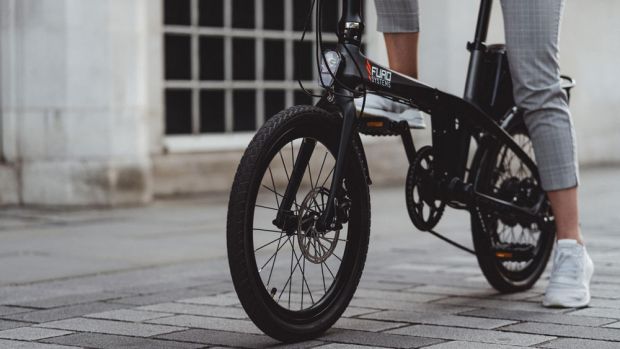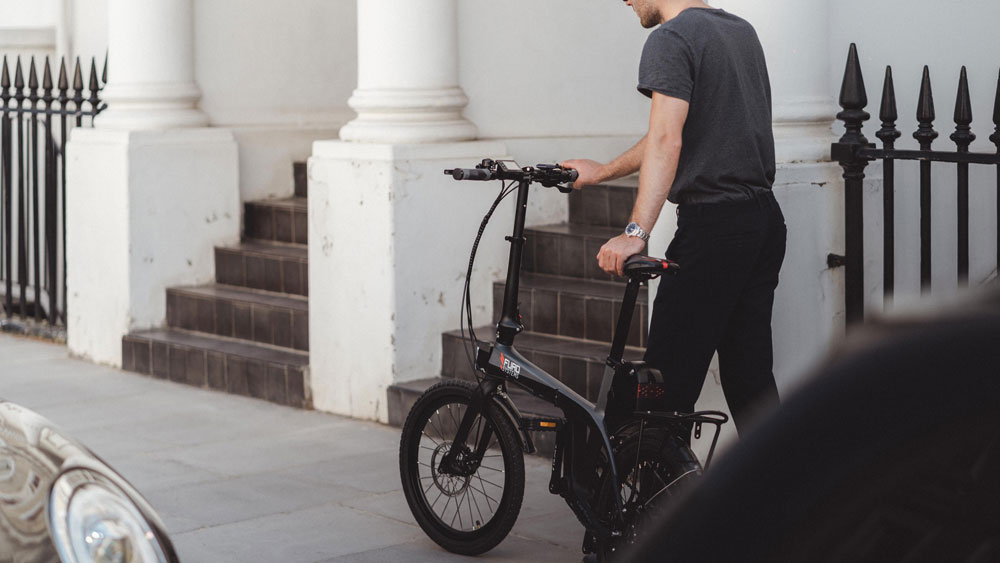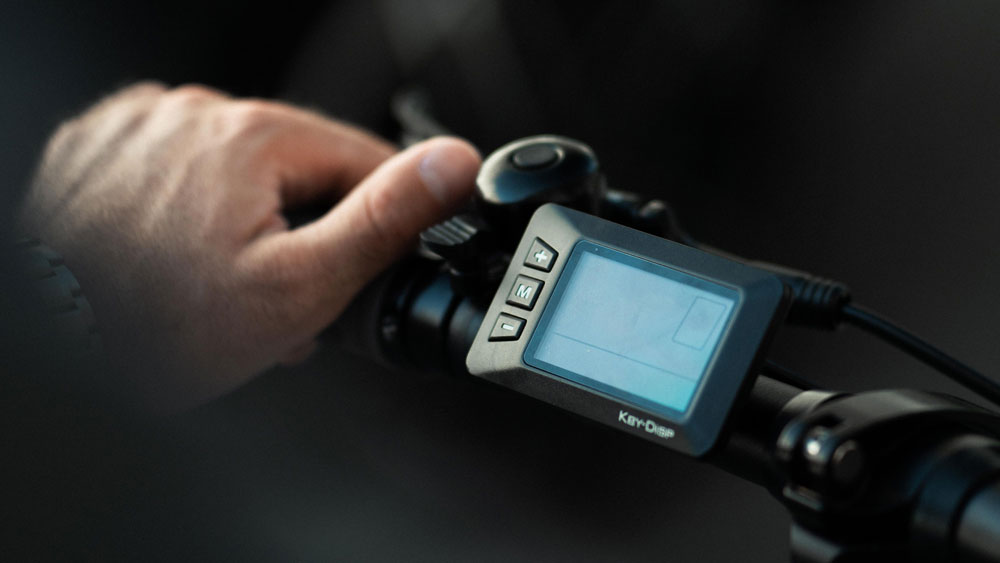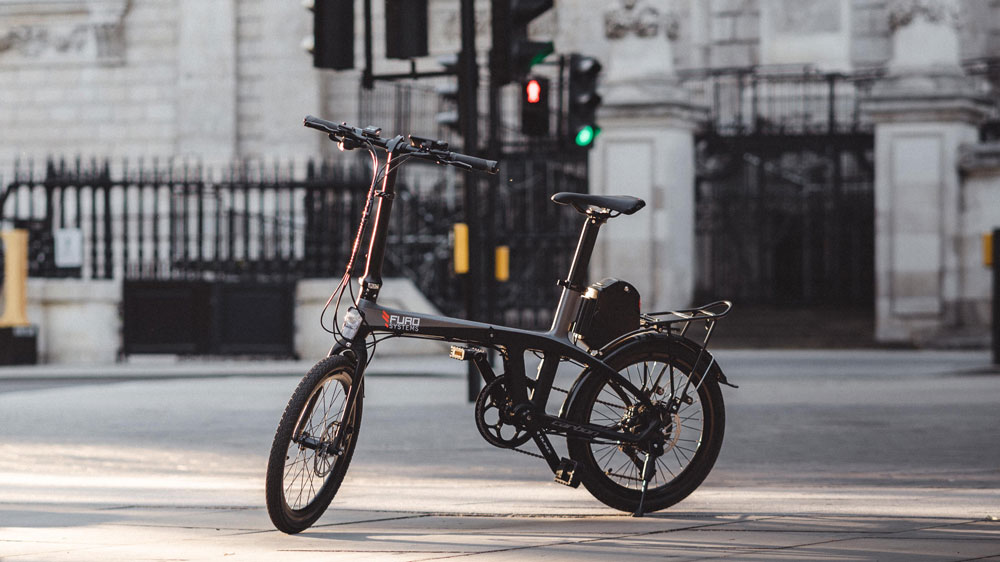You can trust Coach
This is the sixth folding e-bike I have ridden so I feel confident saying that if you want to shop on the budget end of the spectrum, you should still expect to pay between £1,500 and £2,000. There are some models under £1,000, but the one I tried verged on the unrideable.
The Furo X sits squarely in that sub-£2,000 bracket along with the Volt Metro and Raleigh Stow-E-Way. All of them fold twice via a hinge in the middle of the frame and a hinge on the head tube, so the handlebars fold down to sit next to the front wheel. All have 20in wheels, eight or nine gears, a removable battery mounted on the seat tube, a motor with an on-off feel, integrated front and rear lights which run off the battery, and mudguards and a pannier rack fitted as standard.
The Furo X is at the more expensive end of that price range at £1,799, or £1,999 for the “max” version with a bigger battery. It justifies the extra cost with a carbon-fibre frame which brings its total weight down to 15kg, compared with the 20kg Volt Metro LS and Raleigh Stow-E-Way.
Unfortunately it doesn’t make the most of this weight saving. One of the two chief reasons to buy a folding bike is for a mixed commute – one combining, say, train and bike travel. If you’re lifting a bike onto a train then the lighter it is, the better. But there’s no way to secure the folded Furo X, so it flaps open as you carry it – a surprising oversight given the attention to detail displayed elsewhere on the bike.
It also means it’s too unwieldy to carry comfortably while shopping, so it’s inconvenient for running errands with multiple stops. On my test trip I ended up wishing I had brought a bike lock to park it outside.

The other key consideration of a folding bike is the size of the footprint, since storing it inside in a cupboard, hallway or corner is a definite advantage for the garage-less. This is where the Brompton e-bike distinguishes itself by being substantially smaller than the competition (although it does cost substantially more).
The Furo X is 750mm long, 700mm high and 370mm wide when the pedals are folded in. In comparison the Brompton is 585x565x270mm, but it is more than a grand dearer. The Furo X is smaller than its similarly priced competitors though, which gives it an edge. The Volt is 830x760x460mm while the Raleigh is 880x800x440mm.
It’s easy to fold, with just two hinges to operate and a seatpost to unlock and push down. There are clear markings on the seatpost too so you can reset it precisely each time.
I was also impressed by the inclusion of a clamp on the handlebars so you can rotate them forwards or backwards. It’s rare that folding bikes offer this but it’s a minor tweak that can make the riding experience much more comfortable.
The motor packs a decent punch, although I found you couldn’t just leave it on the highest level of assist as I normally do. The motor takes a beat to cut out after you’ve stopped pedalling, so pedalling to drop down the gears as you come to a stop results in a burst of speed (the brakes were always strong enough to bring me to a safe stop, thankfully). A few times I tried to set off in the highest level of assist and the front wheel lifted off the ground. The solution is to shift up and down through the levels of assist, using the buttons on the display conveniently in reach of your left thumb. With a lot of shifting gears and the level of assist in tandem, you can achieve a pleasantly effortless and smooth ride – but it requires more rider input than I’ve come to expect from an e-bike.

One of the Furo X’s distinguishing features is the indicator lights on the removal battery, which sits above the back wheel on the seatpost. Two buttons on the right side of the handlebars allow you to turn the lights off and on. As on the other e-bikes with indicator lights I’ve tried, what seems like a good idea fails to live up to expectations. At first it’s easy to forget they’re there and I don’t expect other road users to be on the lookout for them either. Then once you do start using them it’s easy to forget to switch the indicator off since I found the corresponding flash on the handlebars barely visible in daylight. As I’ve subsequently noticed, if you lash anything to the pannier rack it may obscure the lights, too. Surprisingly, the indicators don’t run off the main battery – there’s a small, separate charging point.
The front and back lights do run off the battery, but I found the back light surprisingly dim. It also seemed to drain the battery much quicker than I expected.
The battery performance, otherwise, was very strong. I rode the Furo X MAX, which has a quoted range of 60km (versus 45km on the standard model), and wrung 51.4km out of it – pretty impressive since I ride in the highest possible level of assist at all times, and ranges tend to be quoted based on favourable conditions. The battery is removable to make charging easier, but requires a key so you don’t have to worry about it being taken off the bike when it’s locked up on the street.
See related
- The Best Electric Bikes For Commuting
- The Best Folding Bikes For Cycling To Work
- Save £££s On An E-Bike Using The Cycle To Work Scheme

The display next to the left handlebar grip lets you keep tabs on the battery level, along with your speed, which of the five levels of assist you’re using, and total distance covered. The screen was easy to read in bright sunlight and also has a backlight so you can see it when riding at night too.
I got on well with the Furo X and being 5kg lighter than its competitors does justify its higher price. It’s a decent option if you’re keen to use an e-bike but can only store your bike indoors. However, if you’re planning to take it on a train I’d think twice. If your budget can stretch far enough, I’d urge you to consider the Brompton Electric which is easier (not easy) to lug around.
Personally, I’d also investigate finding a convenient bike hangar that you can rent a space in, because riding a full-size bike is so much more pleasurable and they’re cheaper. Indeed, Furo’s Aventa hybrid bike starts at £1,399 for a range of 70km.
Buy Furo X from Furo | £1,799-£1,999

Jonathan Shannon was the editor of the Coach website from 2016 to 2024, developing a wide-ranging experience of health and fitness. Jonathan took up running while editing Coach and used the training plans on the site to run a sub-40min 10K, 1hr 28min half marathon and 3hr 6min marathon. He’s an advocate of cycling to work and is Coach’s e-bike reviewer, and not just because he lives up a bit of a hill. He also reviews fitness trackers and other workout gear.

